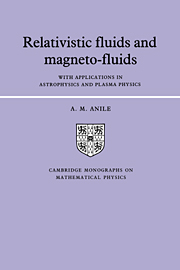Book contents
- Frontmatter
- Contents
- Preface
- 1 Introduction
- 2 Mathematical structure
- 3 Singular hypersurfaces in space-time
- 4 Propagation of weak discontinuities
- 5 Relativistic simple waves
- 6 Relativistic geometrical optics
- 7 Relativistic asymptotic waves
- 8 Relativistic shock waves
- 9 Propagation of relativistic shock waves
- 10 Stability of relativistic shock waves
- References
- Index
4 - Propagation of weak discontinuities
Published online by Cambridge University Press: 06 January 2010
- Frontmatter
- Contents
- Preface
- 1 Introduction
- 2 Mathematical structure
- 3 Singular hypersurfaces in space-time
- 4 Propagation of weak discontinuities
- 5 Relativistic simple waves
- 6 Relativistic geometrical optics
- 7 Relativistic asymptotic waves
- 8 Relativistic shock waves
- 9 Propagation of relativistic shock waves
- 10 Stability of relativistic shock waves
- References
- Index
Summary
Introduction
In the previous chapter we introduced the concept of propagating singular surfaces (or singular hypersurfaces in space-time) and derived the compatibility relations among the jumps of the field variables. When only derivatives of the field variables can be discontinuous across a propagating singular surface, we are dealing with weak discontinuities. When the fields themselves can be discontinuous we have strong discontinuities (among which shock waves are of paramount importance).
Whereas shock waves can be produced from an initially smooth solution as a consequence of nonlinear steepening and breaking, weak discontinuities can only be produced as a result of discontinuities in initial or boundary conditions. For instance, in gas dynamics, a jump in the derivatives of the velocity can appear in a flow along a solid obstacle with angles. Also, a jump in the derivatives of the pressure can appear (among other discontinuities like shocks and contact discontinuities) when the initial condition consists of two adjoining masses of gas compressed to different pressures (Landau and Lifshitz, 1959a). Although conceptually these two examples remain valid also for relativistic fluid motion, for relativistic flow in an astrophysical context only the latter is meaningful. For instance, the case of a cloud moving relativistically in a jet has been considered by Blandford and Königl (1979) in the context of models for the rapid variations in extragalactic radio sources' emissions.
An extremely important application of the concept of weak discontinuity waves is to the study of impulsive gravitational waves.
- Type
- Chapter
- Information
- Relativistic Fluids and Magneto-fluidsWith Applications in Astrophysics and Plasma Physics, pp. 71 - 102Publisher: Cambridge University PressPrint publication year: 1990

